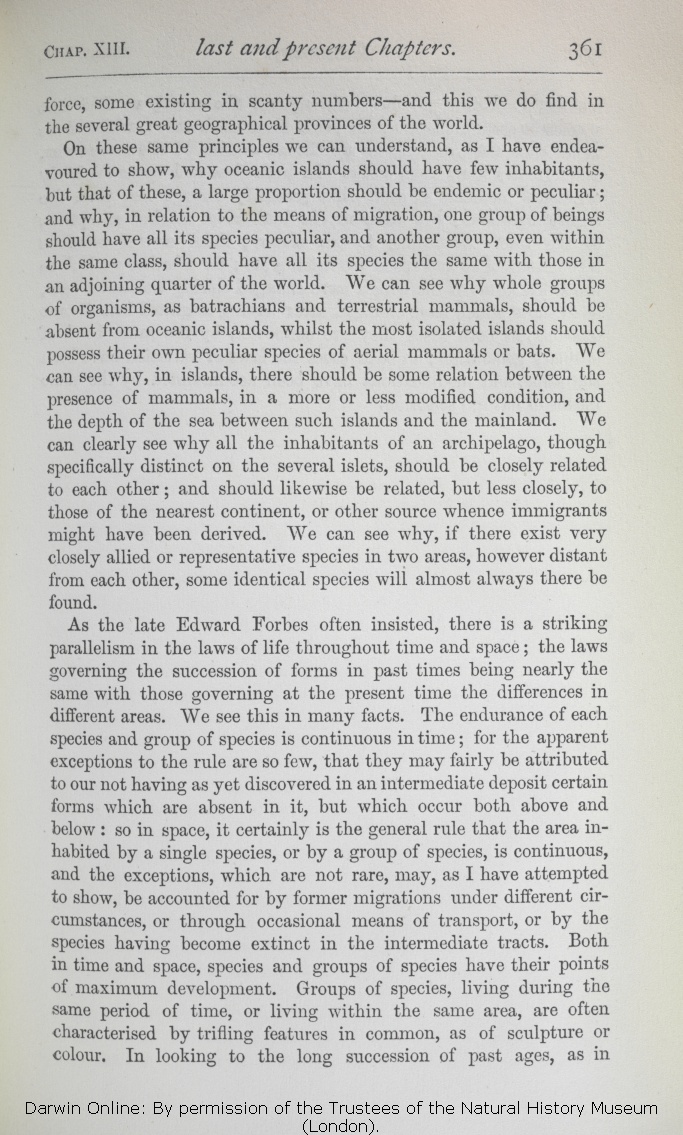On these same
principles | principles 1861 1866 1869 1872 | | principles, 1859 1860 |
| that of 1872 | | of 1859 1860 1861 1866 1869 |
| these, 1872 | | these 1859 1860 1861 1866 1869 |
| large proportion 1872 | | great number 1859 1860 1861 1866 1869 |
| beings 1872 | | beings, 1859 1860 1861 1866 1869 |
| OMIT 1872 |
| even within the same class, 1859 1860 1861 1866 1869 |
| peculiar, 1869 1872 | | endemic, 1859 1860 1861 1866 |
| group, 1872 | | group 1859 1860 1861 1866 1869 |
| even within the same class, should 1872 |
| should 1859 1860 1861 1866 1869 |
| the same with those in an adjoining 1872 |
| common to other 1859 1860 1861 1866 |
| the same with those in other 1869 |
| quarter 1872 | | quarters 1859 1860 1861 1866 1869 |
| should possess 1866 1869 1872 | | possess 1859 1860 1861 |
| aerial 1872 | | aërial 1859 1860 1861 | | aërial 1866 1869 |
| why, 1872 | | why 1859 1860 1861 1866 1869 |
| in islands, there 1872 |
| there 1859 1860 1861 1866 1869 |
| presence 1859 1860 1861 1866 1872 | | presence, 1869 |
| of 1859 1860 1861 1866 1872 |
| in islands, of 1869 |
| condition, 1859 1860 1861 1869 1872 | | condition 1866 |
| and 1859 1860 1861 1869 1872 |
| in islands, and 1866 |
| such 1866 1869 1872 | | an 1859 1860 1861 |
| islands 1866 1869 1872 | | island 1859 1860 1861 |
| other; 1872 | | other, 1859 1860 1861 1866 1869 |
| should likewise 1872 | | likewise 1859 1860 1861 1866 1869 |
| continent, 1872 | | continent 1859 1860 1861 1866 1869 |
| might have been 1869 1872 |
| were probably 1859 1860 1861 |
| had probably 1866 |
| derived. 1859 1860 1861 1869 1872 | | been derived. 1866 |
| why, 1872 | | why 1859 1860 1861 1866 1869 |
| if there exist very closely allied or representative species in 1872 |
| in 1859 1860 1861 1866 1869 |
| some 1872 |
| there should be a correlation, in the presence of 1859 1860 1861 1866 |
| where very closely allied or representative species exist, there should almost always exist some 1869 |
| species 1872 | | species, 1859 1860 1861 1866 | | species. 1869 |
| will almost always there be found. 1872 |
| of varieties, of doubtful species, and of distinct but representative species. 1859 1860 1861 1866 |
| OMIT 1869 |
|
As the late Edward Forbes often insisted, there is a striking parallelism in the laws of life throughout time and
space; | space; 1872 | | space: 1859 1860 1861 1866 1869 |
| apparent exceptions 1872 | | exceptions 1859 1860 1861 1866 1869 |
| certain 1869 1872 | | the 1859 1860 1861 1866 |
| ..... 1869 1872 | | therein 1859 1860 1861 1866 |
| absent 1869 1872 | | absent, 1859 1860 1861 1866 |
| in it, but 1869 1872 |
| but 1859 1860 1861 1866 |
| both above 1866 1869 1872 | | above 1859 1860 1861 |
| continuous, 1869 1872 | | continuous; 1859 1860 1861 1866 |
| former migrations 1866 1869 1872 |
| migration at some former period 1859 1860 1861 |
| circumstances, 1869 1872 | | conditions 1859 1860 1861 1866 |
| through 1866 1869 1872 | | by 1859 1860 1861 |
| or 1866 1869 1872 | | and 1859 1860 1861 |
| living during the same 1866 1869 1872 |
| belonging either to a certain 1859 1860 1861 |
| living within the same 1866 1869 1872 |
| to a certain 1859 1860 1861 |
| features 1866 1869 1872 | | characters 1859 1860 1861 |
| past ages, 1866 1869 1872 | | ages, 1859 1860 1861 |
| ..... 1872 | | now 1859 1860 1861 1866 1869 |
|









